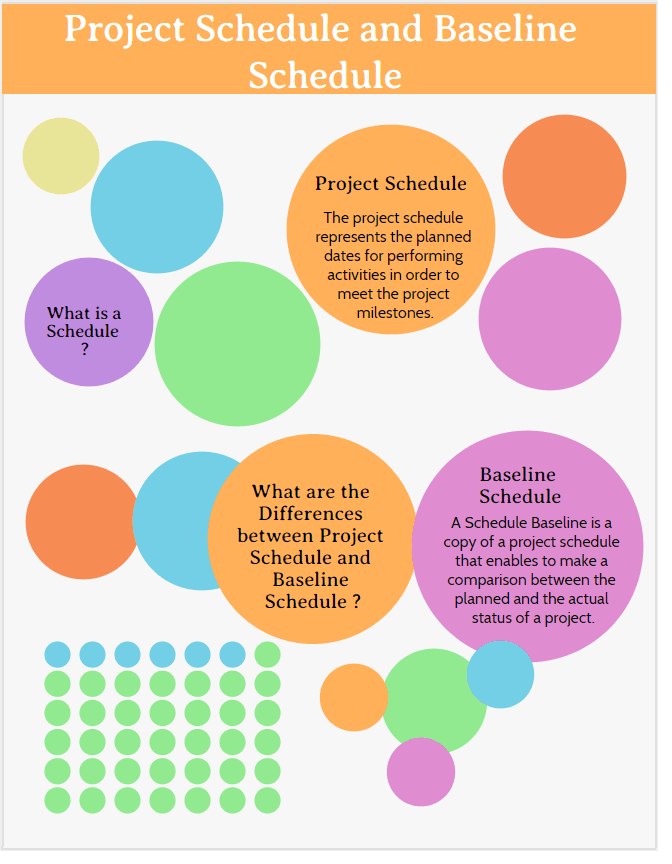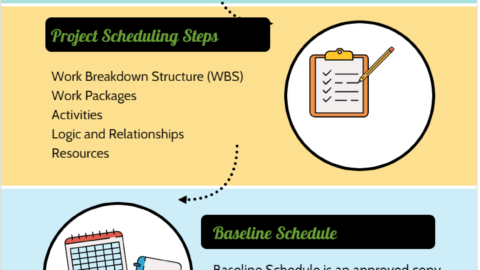Project Schedule vs Baseline Schedule (Schedule Baseline)
There is no difference between schedule, work schedule, and project schedule. These terms can be used interchangeably. However, there are some differences between these concepts. Now we will analyze them in detail.
Table of Contents
What is a Schedule?
In project management, a schedule (also known as work schedule or project schedule) is a chart that includes activity lists, project deliverables, milestones, and their start and completion dates to demonstrate what tasks need to be done.
Duration of deliverables is often estimated by analyzing the quantities, resource availability, activity relationships, constraints, and project requirements.
Gantt Chart, Critical Path Method, PERT Method, Critical Chain Method are some of the most popular methods used to create work schedules in project management.
There are also some software tools such as Primavera P6, Microsoft Project, and Microsoft Excel that can be used to plan and organize activities as well as reporting performance.
Basically, work schedules are commonly used for project, program, and portfolio management purposes.
The development and maintenance of the schedule is a crucial task in many industries, such as engineering, construction, healthcare, and software development. Therefore schedulers and project control teams are employed to create and update work schedules on a regular basis.
Project Schedule
A project schedule is a key project document that communicates what activities need to be completed and which resources should be assigned to complete those activities in what time span. The project schedule represents the planned dates of activities in order to meet the project milestones. Simply put, it details what work needs to be done and which resources must be assigned in order to perform the tasks in a given time period.
Activities are identified, sequences are defined and activity durations are estimated in Project Schedules. Also, the Work Breakdown Structure (WBS), Engineering, Procurement, and Execution parts are detailed in Project Schedules.
How to Create a Project Schedule

Project scheduling works take place during the planning phase. Before creating project network diagrams, ask the following questions yourself to start;
- What will be done?
- When will it start?
- When will it be completed?
- What are the key milestones?
- Where is the location?
- Who is responsible for what?
The answers to the above questions will determine the route of your process. Because the answers are directly related to the start and finish dates, logical relationships, durations, and resource assignments.
Here are the basic steps to be followed in creating a schedule in plan;
Analyze the Project Scope
Project scope determines the major project deliverables. Project objectives, constraints, assumptions, and success factors are described in the project scope. So, analyzing the project scope helps you to create the Work Breakdown Structure (WBS) and determine the project tasks required to complete the project successfully.
By analyzing the scope, you can also gather information related to stakeholder requirements.
Plan the Sequence of Activities
Activities are the smallest jobs that form the work packages and the work packages from the bottom levels of the Work Breakdown Structure. The sequence of activities affects the final deliverable, therefore it is critical to plan the sequence of activities.
Group Activities into Categories
After listing the project activities and planning their sequence, group them into categories to view, filter, and sort easily. For example, you can use groups such as initiation, planning, execution, monitoring, and close. You can also group the activities in order of importance. Thus, you will know which activity affects the major deliverables and which of them does not.
After grouping activities, use milestones to highlight the beginning and end dates of each group.
Build the Project Network Diagram
In a project, activities are linked to each other with logical relationships. Some of the activities can be performed simultaneously, where some tasks can not start until their predecessor activities finish. These logical relationships must be planned to build the project network diagram.
Determine the Critical Path
Building the project network diagram enables you to determine the critical path of the schedule. The critical path method allows you to analyze which activities are delayed and which are performing as planned. This enables you to make decisions such as increasing the number of resources to recover delays.
Allocate Resources
Project activities can not be completed without resources. Therefore, you need to allocate labor, material, and equipment resources to each activity to track the performance and allocate additional resources if needed.
Maintaining Schedules
Once you’ve completed your schedule and checked if it meets your organizational requirements, the maintaining phase comes into play. A static document like a spreadsheet can not help you make performance measurements as the project progresses. Therefore, you need to use software tools to facilitate complex scheduling tasks.
Selecting the best software tool depends on the scale of your projects and your organizational requirements. If your organization often undertakes large and sophisticated projects, you need to use a software tool with high planning and scheduling capabilities.
Baseline Schedule
Schedule Baseline or Baseline Schedule is the approved version of a plan. It is also known as the “Target Schedule”. A Schedule Baseline is a copy of a project schedule that enables to make a comparison between the planned and the actual status of a project.
/>Baselines provide a “target” against which you can track a project’s resource, cost, and schedule performance. Cost and schedule variance of activities are calculated with the help of a schedule baseline.
Typically baselines are created before updating the project schedules for the first time.
At the beginning of a project, the Schedule Baseline is the same as the Project Schedule. As the tasks are performed, the Project Schedule is updated.
Difference between Project Schedule and Baseline Schedule
There are some differences between these two documents. Let’s analyze them in detail.
- The Project Schedule is a “living” document, whereas the Schedule Baseline is the “frozen” version of it.
- The Project Schedule is updated as the project is being executed. On the other hand, the Schedule Baseline is only modified as a result of an approved change request related to project scope changes.
- The Schedule Baseline is a “Target”, whereas the Project Schedule is updated and reported in order to analyze the project’s current status.
- The Project Schedule is a Project Document. On the other hand, the Schedule Baseline (project schedule vs baseline schedule) is a part of the Project Management Plan.
What are Project Scheduling Software Tools?
Creating a project schedule is not something that everybody can do easily. It requires deep knowledge and expertise. While creating a schedule, you need to address what is being scheduled, and for what purposes.
A project consists of many activities and each activity has a planned start and finish date. In a similar way, people plan their time, resources, training programs, education, vacation in order to become successful in their lives.
As you see, there are many things to do. If you want your to stay on track, you should know how to perform planning and scheduling. People have often printed simple charts and used calendars for scheduling purposes in the past. However, in today’s world, planning and scheduling software tools make life easier than before.
It is often difficult to create a project network diagram, plan resources, and update durations over time without using a software tool. Tools facilitate the process of organizing and managing tasks, as well as creating performance reports. Most of the software tools provide team members with a wide spectrum of features that help to create awesome charts and histograms.
Basically, software tools can be divided into two major categories which are desktop and online tools. Each of them has pros and cons.
Desktop or Online Software Tools
The internet connection is the most important feature that distinguishes desktop tools from online tools. A desktop software tool does not rely on the internet connection, just relies on your computer’s speed. However, the performance of online software tools is affected by connectivity. If the internet connection is too slow, your performance drops down.
On the other hand, there are many features that an online tool provides while a desktop tool can not. For example, online software tools provide more flexibility when managers and team members work at the same time but from different locations.
5 Best Practices for
Having a proper schedule in place provides many advantages such as meeting deadlines and managing a number of tasks. In order to improve your management, never forget the following best practices;
Make Sure You Identified All the Activities
Scan properly all project information, documents, drawings, scope in order not to miss a critical activity. Make sure all the driving activities are specified and grouped under certain Work Breakdown Structure levels.
Be Reasonable
While estimating the duration of your activities, be realistic and reasonable. Don’t overestimate or foresee fewer durations than they should be. Use tools to estimate activity duration such as Analogous, Parametric Estimating, Three Point, etc. methods to make sure you set realistic durations.
Assign Correct Relationships
While assigning activity relationships, make sure that relationships reflect real conditions. For example, if Activity A must start only if Activity B finishes, you have to assign a FS (Finish to Start) relationship. If you assign other kinds of relationships such as SS (Start to Start), FF (Finish to Finish) for that example, your network diagram and the critical path will be wrong.
Analyze the Critical Path
After assigning all the logical relationships, it is time to analyze the critical path. Make sure your critical path is correct. Revisit the activities on the critical path and check their dependencies with other activities. Don’t forget, the critical path changes as the project progresses.
Keep Your Floats Under Control
Float is the amount of time that an activity can be delayed without delaying its successor. So, you can have some reasonable floats in order not to make everything critical. However, if most of your activities have too much floats, make sure to check their relationships.
In this article, we discuss how to build a schedule. Are you creating work schedules? If you are, please share your experiences and opinions with us.
External Reference

Linda Maltz is vice president of design and consulting at Cuboca, a project management training and consulting organization specializing in construction management and BIM. She is certified Primavera P6 Trainer.










